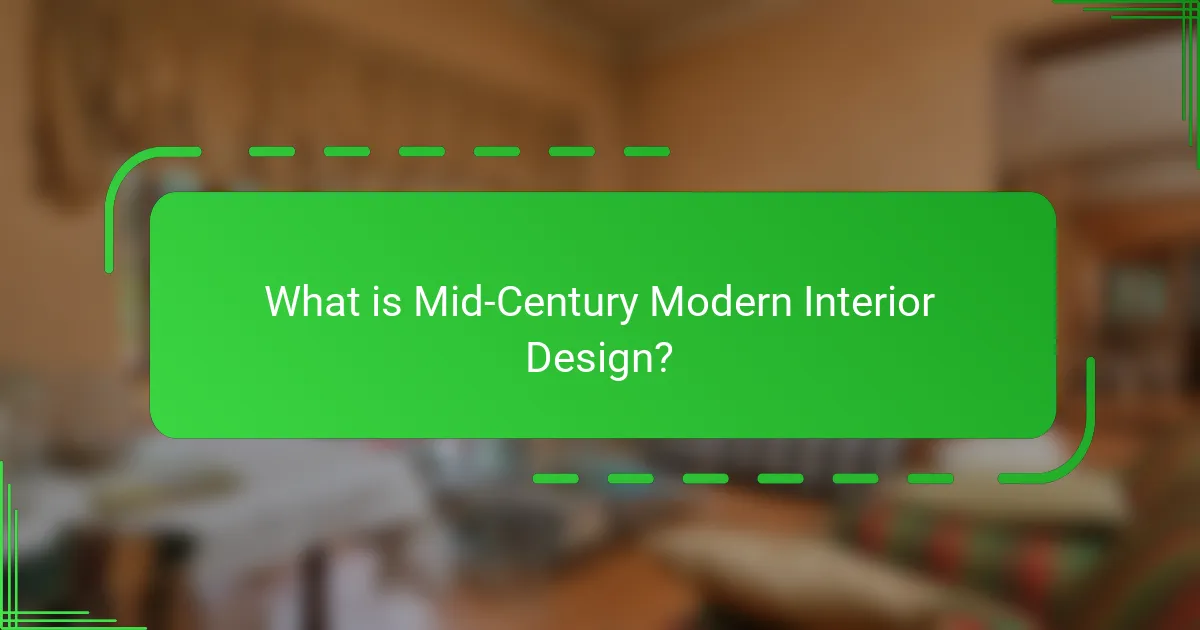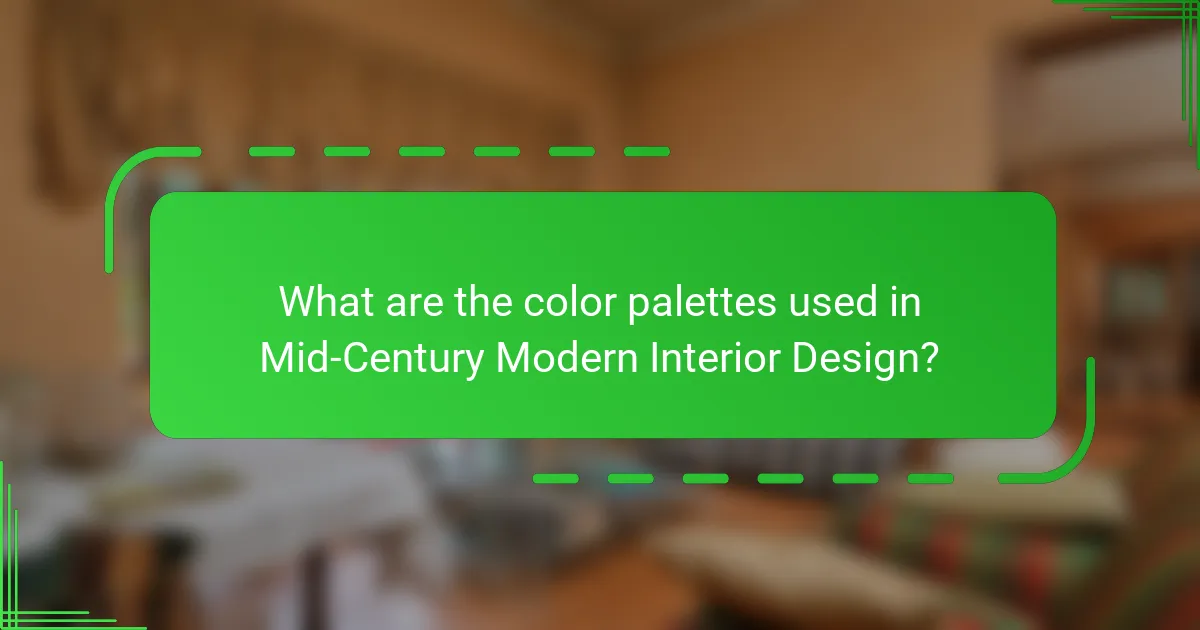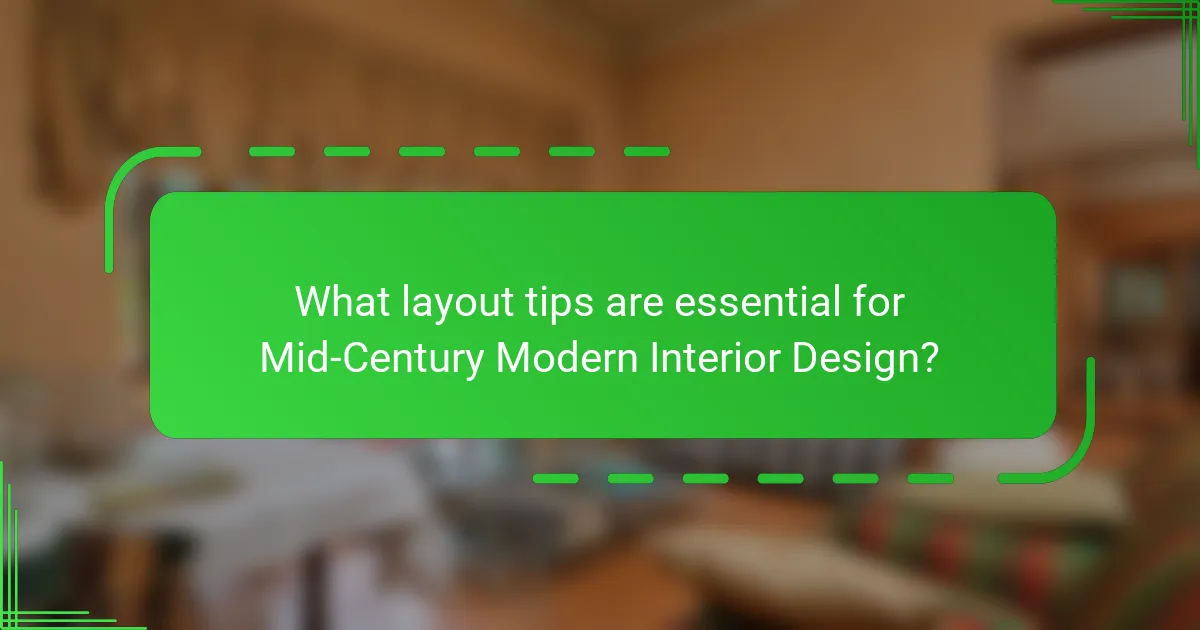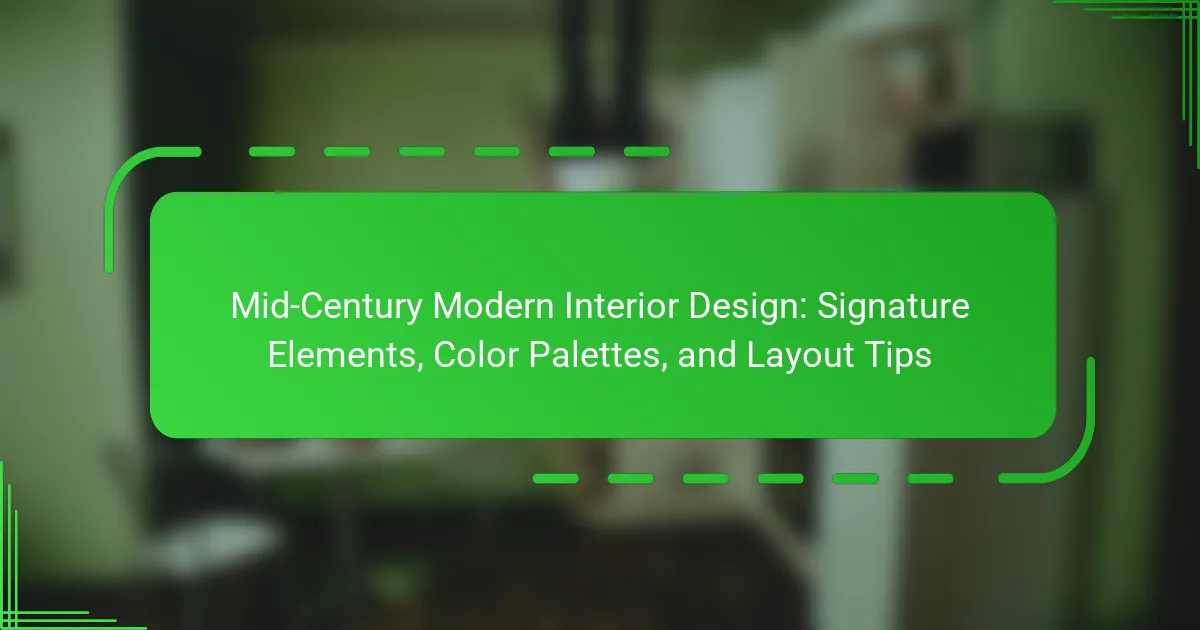Mid-Century Modern Interior Design is a design movement that emerged in the mid-20th century, characterized by clean lines, organic shapes, and a functional aesthetic that emphasizes simplicity and a connection to nature. This style features vibrant color palettes, including mustard yellow, olive green, and burnt orange, often paired with neutral tones to create warmth and sophistication. Essential layout tips for this design include open floor plans, functional furniture arrangements, and the use of geometric shapes to enhance flow and interaction. The article explores the signature elements, color palettes, and layout strategies that define Mid-Century Modern design and its enduring influence on contemporary interiors.

What is Mid-Century Modern Interior Design?
Mid-Century Modern Interior Design is a design movement that emerged in the mid-20th century. It is characterized by clean lines, organic shapes, and a functional aesthetic. This style emphasizes simplicity and integration with nature. Furniture pieces often feature natural materials like wood and leather. Bright, bold colors are commonly used alongside neutral tones. Iconic designers such as Charles and Ray Eames popularized this movement. Mid-Century Modern design continues to influence contemporary interiors today. Its enduring appeal lies in its timeless elegance and practicality.
How did Mid-Century Modern Interior Design emerge?
Mid-Century Modern Interior Design emerged in the mid-20th century. It was influenced by the post-World War II era, which emphasized simplicity and functionality. Designers sought to create spaces that reflected modern living. Key figures included architects like Richard Neutra and Charles Eames. The movement was characterized by clean lines and organic forms. Innovative materials such as plywood and fiberglass were widely used. This design style gained popularity through furniture and home decor exhibitions. Its principles continue to influence contemporary design today.
What historical events influenced the development of this design style?
The development of Mid-Century Modern interior design was influenced by several historical events. The end of World War II in 1945 led to a housing boom in the United States. This increased demand for affordable housing drove innovation in design. The rise of the Bauhaus movement in Germany also impacted this style. Bauhaus emphasized functionality and simplicity, which became key principles in Mid-Century Modern design. Additionally, advancements in materials and technology during the 1950s allowed for new design possibilities. The post-war economic prosperity allowed consumers to invest in modern furniture. Furthermore, the cultural shift towards informal living spaces reflected changing social norms. These events collectively shaped the aesthetic and functional aspects of Mid-Century Modern interior design.
Who were the key figures in Mid-Century Modern design?
Key figures in Mid-Century Modern design include Charles and Ray Eames, George Nelson, and Eero Saarinen. Charles and Ray Eames were influential in furniture design, particularly with their molded plywood chairs. George Nelson contributed iconic pieces like the Marshmallow Sofa and the Ball Clock. Eero Saarinen is known for his sculptural furniture and architectural designs, including the TWA Flight Center. Other notable figures include Arne Jacobsen, whose Egg Chair remains a classic, and Richard Neutra, recognized for his modernist architecture. These designers shaped the aesthetic and functional principles of the Mid-Century Modern movement.
What are the defining characteristics of Mid-Century Modern Interior Design?
Mid-Century Modern Interior Design is characterized by simplicity, functionality, and integration with nature. This design style emerged in the mid-20th century, primarily between the 1940s and 1960s. Key features include clean lines, organic shapes, and a lack of excessive ornamentation. Furniture is often low to the ground and features tapered legs. Natural materials like wood, leather, and stone are commonly used. Color palettes typically consist of earthy tones combined with bright accent colors. Large windows and open floor plans emphasize a connection to the outdoors. Iconic designers such as Charles and Ray Eames popularized this aesthetic, influencing modern design significantly.
What signature elements define this design style?
Mid-Century Modern interior design is characterized by clean lines, organic forms, and functional furnishings. Signature elements include minimal ornamentation and an emphasis on simplicity. The use of natural materials like wood is prevalent. Bold colors and geometric patterns often enhance the aesthetic. Large windows are common, promoting a connection with nature. The design prioritizes open spaces and a seamless flow between rooms. Iconic furniture pieces, such as Eames chairs, exemplify the style’s focus on form and function. This design movement emerged in the mid-20th century, reflecting post-war optimism and innovation.
How does the functionality of Mid-Century Modern design play a role?
Functionality in Mid-Century Modern design emphasizes simplicity and practicality. This design movement prioritizes clean lines and open spaces, which enhance usability in living areas. Furniture is often multi-functional, serving various purposes without sacrificing aesthetic appeal. For instance, many pieces feature built-in storage solutions, maximizing space efficiency. The integration of natural materials like wood and stone also reflects a focus on durability and sustainability. Additionally, the design encourages a seamless flow between indoor and outdoor spaces, promoting a connection with nature. Historical context shows that this approach emerged post-World War II, responding to the need for affordable, efficient living solutions.

What are the color palettes used in Mid-Century Modern Interior Design?
Mid-Century Modern Interior Design typically features color palettes that are vibrant and earthy. Common colors include mustard yellow, olive green, and burnt orange. These hues reflect the natural landscape and are often paired with neutral tones like white, beige, and gray. The use of bold colors creates a striking contrast against wood and metal elements. Pastel shades, such as mint green and blush pink, are also popular in this design style. This approach emphasizes a connection to nature and a sense of playfulness. Overall, the color palettes in Mid-Century Modern design are carefully curated to evoke warmth and sophistication.
What colors are commonly associated with this design style?
Mid-Century Modern interior design is commonly associated with earthy tones, bold colors, and vibrant hues. Earthy shades include olive green, mustard yellow, and terracotta. These colors reflect the natural materials often used in Mid-Century Modern spaces. Bold colors such as teal, orange, and red are also prevalent. They add a lively contrast to the more muted tones. Additionally, neutrals like white, beige, and gray serve as a backdrop, allowing other colors to stand out. This color palette reflects the design’s emphasis on simplicity and functionality. The combination of these colors creates a harmonious and inviting atmosphere typical of the Mid-Century Modern style.
How do these colors influence the overall aesthetic?
Colors significantly influence the overall aesthetic of Mid-Century Modern interior design. They create mood and evoke emotions. Earthy tones like olive green and mustard yellow are commonly used. These colors reflect the natural environment, promoting a sense of tranquility. Bold colors, such as teal and orange, add vibrancy and energy. They create focal points that draw attention. Neutral shades provide balance and allow other colors to stand out. The combination of these colors contributes to a harmonious and inviting space. This aesthetic is characterized by simplicity and functionality, aligning with the design philosophy of the era.
What are the psychology and emotions behind these color choices?
Color choices in design evoke specific psychological responses and emotions. For example, blue often conveys calmness and stability, promoting a sense of peace. Yellow, on the other hand, is associated with happiness and energy, stimulating creativity. Green represents nature and tranquility, fostering relaxation and balance. Red can evoke passion and urgency, often stimulating excitement or action. Each color’s psychological impact is rooted in cultural associations and personal experiences. Research shows that color influences mood and behavior, affecting perceptions of space. Studies indicate that environments with thoughtfully chosen colors can enhance well-being and productivity.
How can one effectively incorporate color into a Mid-Century Modern space?
To effectively incorporate color into a Mid-Century Modern space, use a balanced palette that reflects the era’s aesthetic. Focus on bold, saturated hues like teal, mustard, and orange. These colors can be introduced through accent walls, furniture, or decor. Pair these vibrant colors with neutral tones such as white, gray, or beige to maintain balance. Utilize geometric patterns in textiles and art to enhance the visual interest. Incorporating natural wood tones complements the color scheme and adds warmth. The use of plants can also introduce organic color and texture. Historical context shows that Mid-Century Modern design often embraced a playful yet sophisticated approach to color, making it essential to maintain that spirit in your choices.
What tips are there for selecting the right color combinations?
To select the right color combinations for Mid-Century Modern interior design, start by understanding the color wheel. Use complementary colors to create contrast. Analogous colors offer harmony and balance. Consider the mood you want to evoke; warm colors can energize a space, while cool colors provide calmness. Limit your palette to three main colors for cohesion. Test colors in different lighting to see how they change. Incorporate neutral tones to ground vibrant colors. Historical context shows that Mid-Century designs often used bold colors with natural materials, enhancing visual interest.
How can color impact the perception of space in Mid-Century Modern design?
Color significantly impacts the perception of space in Mid-Century Modern design. Light colors can create an airy, open feel, making small spaces appear larger. For example, shades like white, beige, and pastels reflect more light. This enhances brightness and visual expansiveness. Conversely, darker colors can add depth but may make spaces feel cozier or smaller. Mid-Century Modern design often incorporates bold colors for accent pieces, which can draw attention and create focal points within a room. The strategic use of color also influences mood and atmosphere, contributing to the overall aesthetic. Research shows that color psychology plays a crucial role in spatial perception, influencing how individuals experience and interact with their environment.

What layout tips are essential for Mid-Century Modern Interior Design?
Essential layout tips for Mid-Century Modern Interior Design include open floor plans and functional furniture arrangement. Open spaces enhance flow and natural light, which are key characteristics of this style. Furniture should be positioned to encourage conversation and interaction. Use low-profile pieces to maintain sight lines and create an airy feel. Incorporate geometric shapes in layout design to reflect the era’s aesthetic. Balance is important; distribute furniture evenly across the space. Utilize area rugs to define zones without obstructing flow. Lastly, ensure that each area serves a purpose, aligning with the functional philosophy of Mid-Century Modern design.
How should furniture be arranged in a Mid-Century Modern space?
Furniture in a Mid-Century Modern space should be arranged to promote openness and functionality. This design emphasizes clean lines and minimal clutter. Place larger furniture pieces like sofas against walls to create a clear flow. Use geometric shapes and organic forms to enhance visual interest. Incorporate multi-functional pieces, such as storage ottomans or coffee tables with hidden compartments. Position furniture to encourage conversation, ensuring seating is oriented towards one another. Utilize area rugs to define spaces within open floor plans. Balance the arrangement with a mix of textures and materials, including wood, metal, and fabric. This approach aligns with the principles of Mid-Century Modern design, which values simplicity and practicality.
What principles guide furniture placement in this design style?
Furniture placement in Mid-Century Modern design emphasizes functionality and simplicity. The layout typically promotes an open and airy feel. Key principles include creating a focal point, often using a statement piece like a sofa or artwork. Furniture is arranged to facilitate conversation and movement. Additionally, balance and proportion are essential, ensuring that pieces complement one another. The use of geometric shapes and clean lines further enhances the aesthetic. Natural light is maximized, with furniture positioned to take advantage of windows. These principles reflect the design’s overall ethos of blending form and function seamlessly.
How does spatial flow affect the layout of a Mid-Century Modern room?
Spatial flow significantly influences the layout of a Mid-Century Modern room. This design style emphasizes open spaces and seamless transitions between areas. The arrangement of furniture is often strategic to promote movement and accessibility. For instance, low-profile furniture allows for unobstructed sightlines, enhancing the sense of space. Additionally, the use of organic shapes and lines contributes to a natural flow throughout the room.
In Mid-Century Modern design, areas are often defined by functional zones rather than walls. This encourages a fluid interaction between spaces, such as the living and dining areas. The incorporation of large windows and sliding doors further enhances spatial flow by connecting indoor and outdoor environments. Overall, effective spatial flow in Mid-Century Modern rooms fosters a sense of harmony and balance, aligning with the aesthetic principles of the style.
What are the best practices for creating a cohesive Mid-Century Modern layout?
To create a cohesive Mid-Century Modern layout, focus on clean lines and functional furniture. Select pieces that embody the iconic aesthetic, such as tapered legs and organic shapes. Use a neutral color palette with pops of bold colors for accents. Incorporate natural materials like wood and leather to enhance warmth. Ensure that space flows seamlessly by arranging furniture for conversation. Balance the layout with open spaces and minimal clutter. Utilize statement pieces, like a large artwork or a unique light fixture, to anchor the room. Adhering to these principles will reflect the essence of Mid-Century Modern design.
How can one balance open spaces with functional areas?
To balance open spaces with functional areas, designers should create distinct zones while maintaining visual continuity. This can be achieved using furniture arrangement to define areas without walls. For instance, a sofa can separate a living space from a dining area. Additionally, incorporating rugs can visually delineate spaces. Utilizing different lighting fixtures can also highlight functional areas while preserving an open feel. Plants and screens can provide privacy without closing off the space. According to a study by the American Society of Interior Designers, effective space planning enhances both functionality and aesthetics in open layouts.
What role do accessories play in enhancing the layout?
Accessories play a crucial role in enhancing the layout of mid-century modern interior design. They provide visual interest and can create focal points within a space. Accessories such as vases, art pieces, and decorative objects add personality to the layout. They can also help define different areas within an open floor plan. Strategically placed accessories can guide the eye throughout the room. This technique enhances the overall flow and coherence of the design. Additionally, accessories can introduce texture and color, enriching the mid-century modern aesthetic. The right accessories complement signature elements like clean lines and organic forms, reinforcing the design’s principles.
What practical tips can help achieve a successful Mid-Century Modern interior?
To achieve a successful Mid-Century Modern interior, focus on clean lines and functional furniture. Use pieces that emphasize simplicity and organic shapes. Incorporate bold colors and geometric patterns to enhance the aesthetic. Choose materials like wood, metal, and glass for authenticity. Integrate iconic designs from the era, such as Eames chairs or Noguchi tables. Ensure open spaces to promote a sense of flow and connection. Accessorize with vintage art and decor to add character. Lighting should be functional yet stylish, utilizing fixtures that reflect the era’s design principles.
Mid-Century Modern Interior Design is a design movement characterized by clean lines, organic shapes, and a functional aesthetic that emerged in the mid-20th century. This article explores the defining characteristics of this style, including its historical influences, key figures, and signature elements such as color palettes and layout tips. It highlights the importance of simplicity and integration with nature, as well as practical advice for achieving a cohesive Mid-Century Modern interior. The content provides insights into how color choices and furniture arrangement can enhance spatial flow and overall design coherence.
